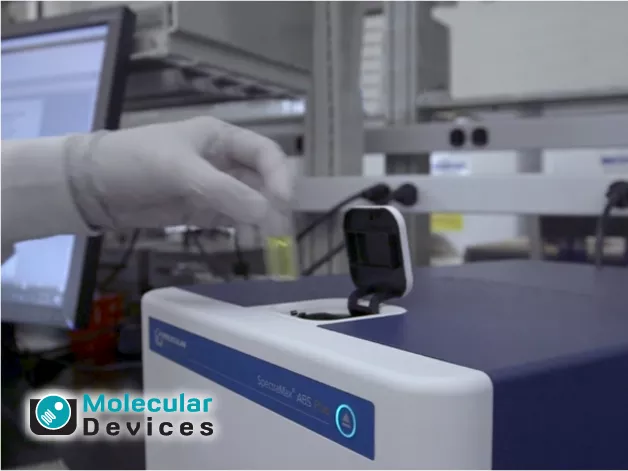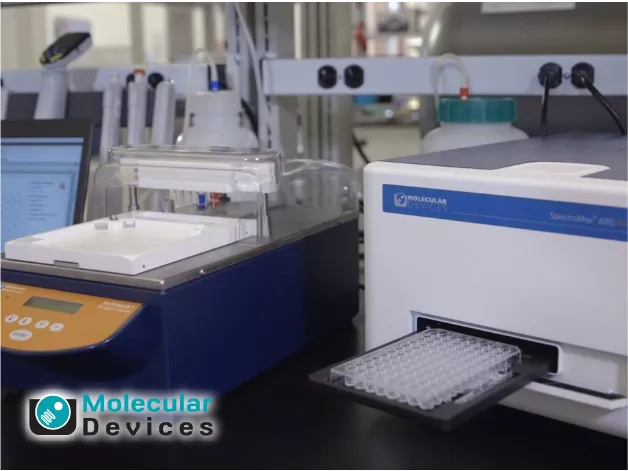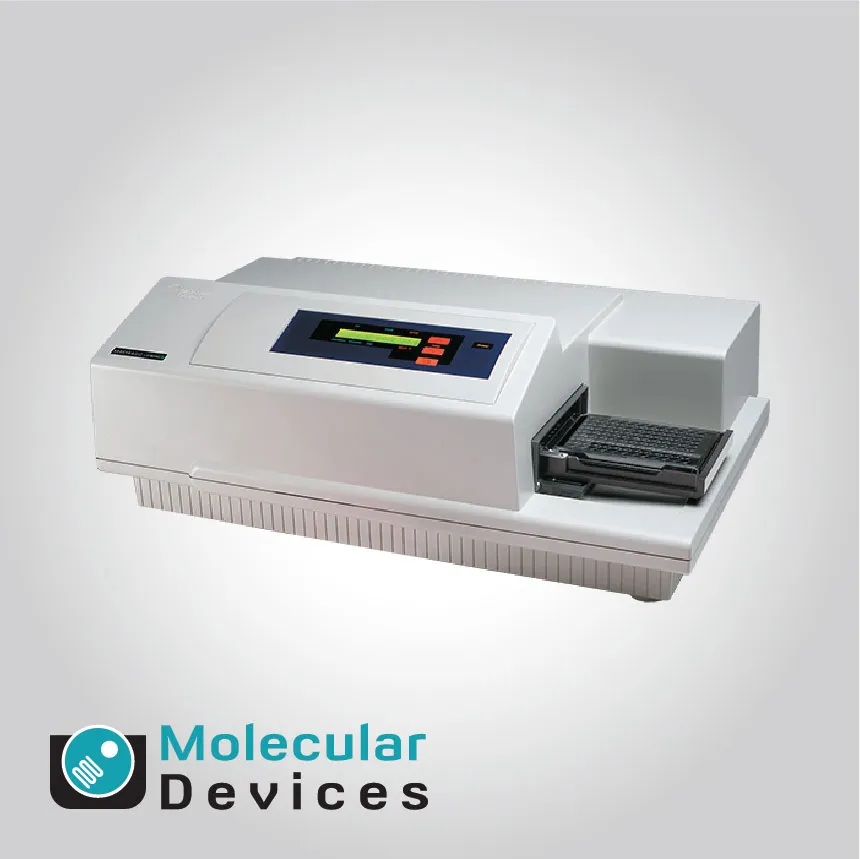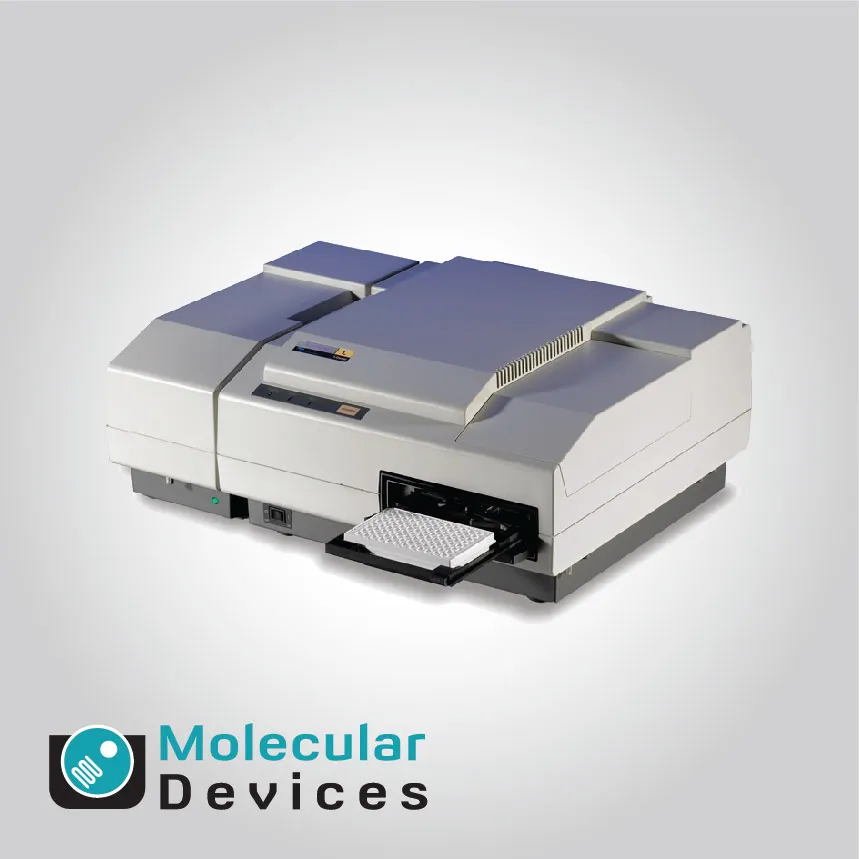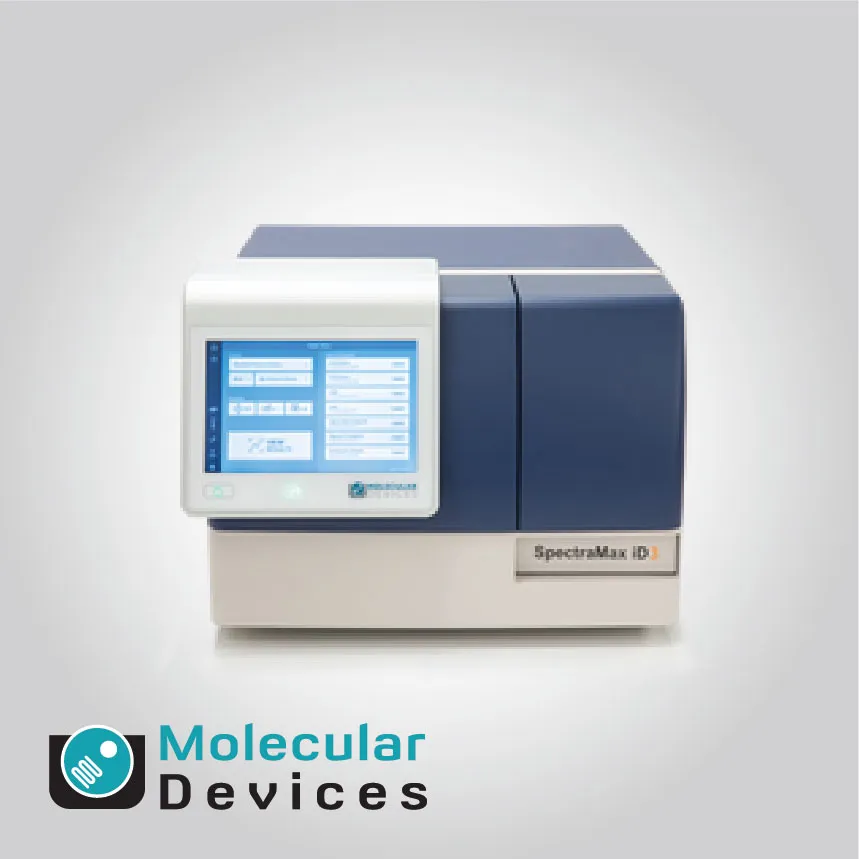
Home » Products » Microscopy & Imaging Systems » Microscopes & Optics » Molecular Devices Absorbance Single-Mode Microplate Reader
Absorbance Single-Mode Microplate Reader
SpectraMax Spectrophotometers
Molecular Devices Absorbance Single-Mode Microplate Reader
Microplate readers are versatile analytical instruments central to modern life science research, designed for the simultaneous detection and measurement of biological, chemical, or physical events within multi-well plates. These systems operate by detecting light signals resulting from reactions, which are then converted into electrical current by highly sensitive detectors, such as photomultiplier tubes (PMTs).
The resulting current is quantified by integrated software to produce numerical results. The versatility of these readers stems from their ability to offer multiple detection modes—including the fundamental trio of absorbance, fluorescence, and luminescence—often complemented by specialized modules like time-resolved fluorescence (TRF) and fluorescence polarization (FP), making them essential for high-throughput screening (HTS) and advanced biochemical studies requiring a sophisticated understanding of light-sample interaction dynamics.
Core Microplate Reader Technology and Applications
The fundamental operation of these laboratory instruments involves utilizing a precisely controlled light source, an optical system for wavelength selection (either via broadband filters or tunable monochromators), and a highly sensitive PMT detector to measure the intensity of light transmitted, emitted, or scattered by the samples. This core technical foundation supports a broad spectrum of plate-based assays, crucial for areas such as general protein quantitation methods, detailed enzyme kinetics studies, and gene expression analysis. By accommodating high-density microplates, the technology inherently facilitates parallel processing, significantly increasing laboratory throughput and efficiently streamlining complex workflows for both basic life science research and demanding drug discovery campaigns.
Advanced Multi-Mode Detection Capabilities
Beyond the core single-mode capabilities, advanced systems frequently utilize a hybrid optical configuration—cleverly combining the spectral flexibility of monochromators with the superior sensitivity of filters—to deliver exceptional performance across diverse assay types. This comprehensive multi-mode approach provides the necessary versatility to measure complex biophysical interactions such as Fluorescence Polarization (FP) and advanced energy transfer techniques like FRET and AlphaScreen. The highly configurable and often modular design allows researchers to readily upgrade or add sophisticated detection technologies and advanced imaging capabilities as their research objectives evolve and new experimental methodologies are adopted.
Industry-Leading Data Acquisition and Analysis Software
The industry-leading data analysis software platform provides comprehensive control over the instrument hardware and sophisticated interpretation capabilities for high-volume results. It dramatically simplifies experimental setup with intuitive, preconfigured protocols and advanced workflow tools, which are essential for accelerating research timelines. Crucially, the software provides powerful data manipulation features, including automated calculation of final results from raw optical measurements and a vast selection of robust curve fitting models. This functionality is pivotal in rapidly and reliably transforming complex, high-volume data into statistically significant and meaningful scientific conclusions, supporting highly reproducible research.
Regulatory Compliance and Validation Assurance
Maintaining operational integrity and data quality in regulated environments, such as those adhering to Good Manufacturing Practices (GMP) or Good Laboratory Practices (GLP), necessitates robust compliance solutions. A comprehensive suite of validation services is offered, including the critical stages of Installation Qualification (IQ), Operational Qualification (OQ), and Preventive Maintenance (PM), all performed against stringent standards. Furthermore, specialized compliance software packages are meticulously designed to facilitate audit readiness and assist in achieving full compliance with strict regulatory guidelines, specifically those pertaining to data integrity and security, thereby ensuring data traceability and system validation across the entire operational lifecycle of the microplate reader.
Precision Environmental and Temperature Control
To enable highly accurate and reproducible measurements for temperature-sensitive biochemical and cell-based assays, microplate readers incorporate precision temperature regulation systems. These thermal controls are capable of maintaining temperatures typically ranging from a few degrees above ambient conditions up to a high-degree Celsius maximum. Crucially, specific models offer optional advanced environmental controls, such as user-installable gas mixers for CO2 and O2, which are vital for maintaining the optimal physiological conditions necessary for extended live cell assays, microbial growth experiments, and complex, time-sensitive cellular kinetics studies, ensuring the highest biological relevance for the acquired data.
Optical Path Optimization and Sensitivity
Achieving maximum signal quality and minimizing measurement noise, particularly in low-volume or optically challenging samples, relies heavily on sophisticated optical path optimization features. High-end systems often include automated mechanisms for precise adjustment of the detection distance, known as Z-height optimization, which is crucial for maximizing signal intensity and ensuring measurement reliability across various microplate types and volumes. The utilization of high-efficiency optical components, sometimes coupled with an ultra-cooled detector (PMT), collectively ensures a wide dynamic range and superior selectivity, which is particularly beneficial for demanding fluorescence and luminescence measurements where signal-to-noise ratio is critical.
High-Throughput Screening and Laboratory Automation
For large-scale drug discovery programs and high-volume screening initiatives, microplate readers are strategically engineered for seamless high-throughput functionality. They are designed to integrate perfectly into complex automated workflows, often supported by essential peripherals such as powerful microplate stackers and washers. This foundational focus on laboratory automation allows for the construction of flexible, scalable, and future-proof workcells capable of executing hundreds or thousands of plate-based assays daily. This capability to process high volumes of samples rapidly is a fundamental requirement for accelerating the entire research and development pipeline, enabling faster decision-making based on robust data.
Sample Versatility and Micro-Volume Quantification
The intrinsic flexibility of the microplate reader extends to accommodating a variety of sample formats beyond the standard multi-well plate. While optimized for high-density plates, specialized accessories are available for accurate quantification of very small sample volumes, typically in the microliter range (2 to 4 µL), directly without requiring external dilution. This micro-volume capability eliminates the need for separate dedicated low-volume instruments. Furthermore, dedicated adapter plates allow for the simple and convenient use of standard cuvettes, providing additional sample versatility for initial method development studies or for analyzing low-volume, precious samples where minimal reagent use is paramount.
Read More About Molecular Devices Products Here






